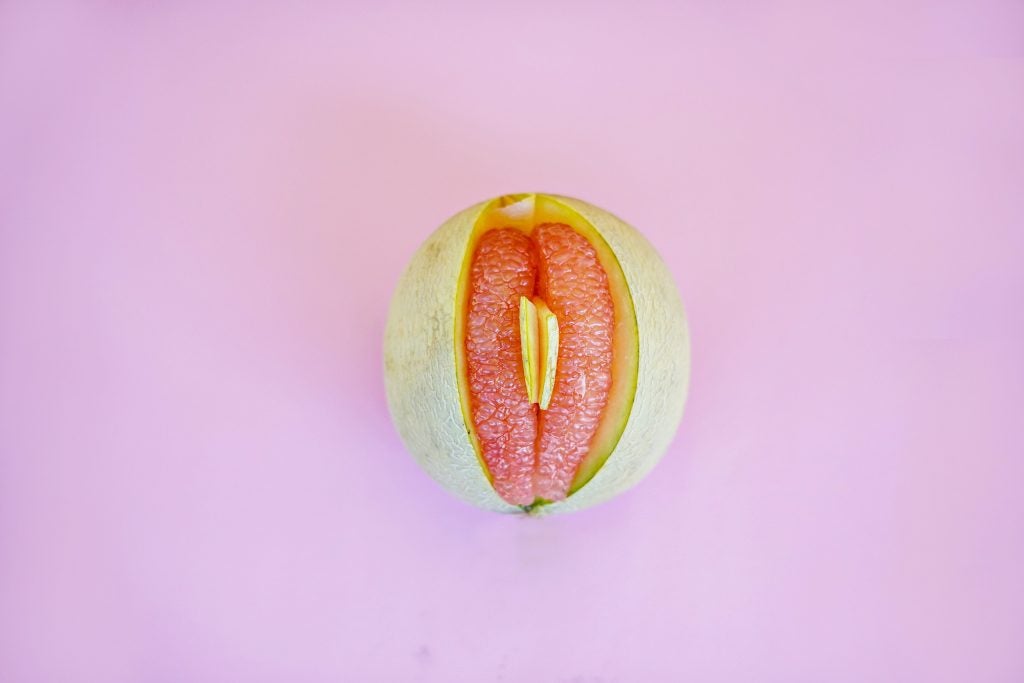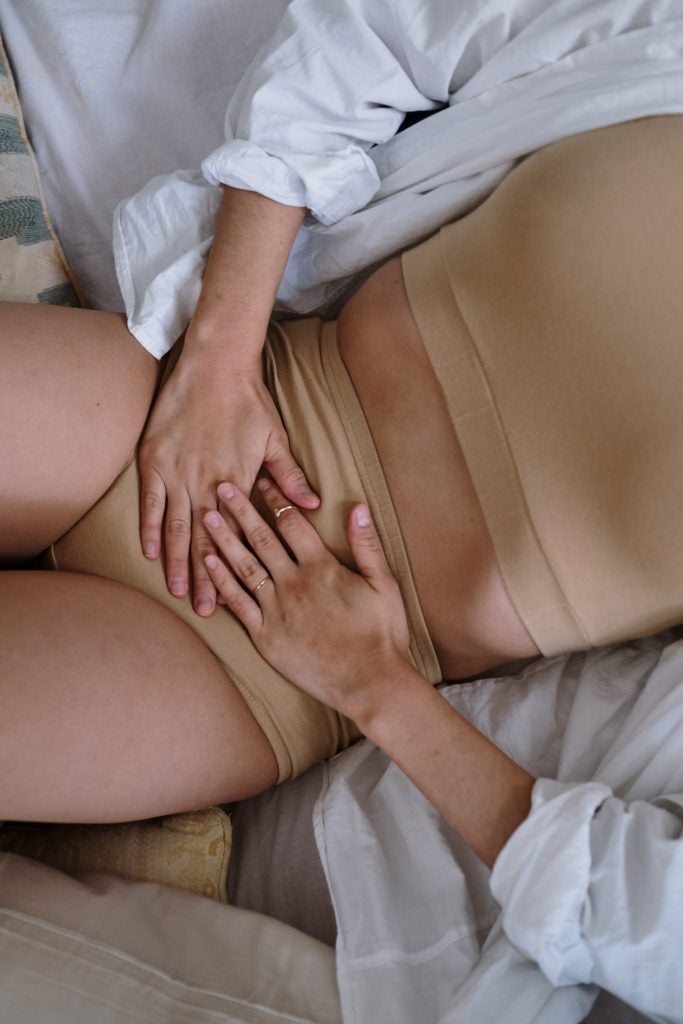
Most people have probably heard about or experienced the fart-like noise that can occur while having sex, commonly known as a “queef,” “vart,” “pussy fart,” or “fanny fart,” among other names. These names can be, and often are, very misleading. A queef is simply an expulsion of air from the vagina. It is usually odorless because it is not a byproduct of waste in the body.1 Queefing is a common and natural experience. It is nothing to be ashamed or embarrassed about and it does not imply any type of health concern.
Table of Contents
Causes of Vaginal Flatulence

When a female is aroused during intercourse, her vagina expands and excess air enters it. Once the penis enters, the air does not have as much space inside of the vagina to occupy, so it is forced out of the vagina abruptly. This expulsion of air will often result in an audible noise, or a queef.2
In general, the more times the penis is completely withdrawn from the vagina and reinserted, the more likely a female is to expel air from her vagina. The noise itself is caused by the vibration of air passing out of the vaginal structures.2 Changing positions frequently during sex can increase the occurrence of queefs, since air is likely to enter the vagina when the penis is removed. When the female is penetrated again, the air will be pushed back out.1
A queef may also happen during the resolution phase of the sexual response cycle. During this time, the vaginal canal shrinks back to its normal size and air can be expelled.2 Similarly, queefing can occur during a pelvic exam, when a doctor inserts a speculum into the vagina. Pregnancy or menopause can also lead to more episodes of vaginal flatulence.1
Queefing also commonly occurs during exercise, especially in yoga positions, sit-ups, and stretching. These movements encourage the passage of air into and out of the vaginal canal. Fart-like noises coming out of any type of orifice can be embarrassing, especially when in a public setting such as the gym, but do not be concerned if you queef or hear a queef in public! Queefs do not emit any type of odor and they often sound louder to the person who queefed then to the surrounding people.
How Should You Handle It During Sex?
Many people find queefing to be an embarrassing event since it not only resembles the sound of a fart, but it also occurs during a person’s most intimate sexual moments. Queefing is a common and natural bodily function that does not have to ruin the mood or affect the quality of a sexual experience. There are many ways that queefing can be addressed, or even unaddressed, to allow for both partners to feel comfortable and allow for the sexual experience to continue with ease:

- Ignore the noise and continue with your sexual experience. Queefing happens and if you do not feel the need to address it, then do not worry about it! You can always bring it up afterwards if you feel that you want to clarify things with your partner.
- Address it, laugh it off, and then move past it. If the sound catches you or your partner off guard, the funny noise might spark a laugh between either yourself or your partner, which is completely natural! Keeping a light-hearted attitude about the situation is a good way to avoid feeling embarrassed or awkward about the event.
- Suggest a different sex position or move to your partner. This recommendation can serve as a “change in subject” which may distract from any awkward tensions, while also remedying the potential source of the queefing. See the section below, “How to Reduce Queefing Episodes” for more information.
- Engage in some sexy talk with your partner and offer them words of encouragement. Giving your partner some positive feedback and emphasizing how much you are enjoying the sexual experience can reduce any awkwardness you or your partner might feel and bring you both back into the intimate moment.
Maintaining an open and honest communication system with your partner can help diffuse awkward moments caused by queefing. You might discover that your partner does not even notice or mind queefing, or they may not know that your queefs makes you feel uncomfortable. Talk to your partner and ask questions to further build up your self-confidence if you are feeling worried or embarrassed.
How to Reduce Queefing Episodes

In general, queefing is an unavoidable occurrence, just as farting from the anus is. However, there are some measures that can be taken to reduce the chances of experiencing a queef. Although queefing is a severely underresearched subject area, some recent studies have indicated that Kegel exercises can strengthen pelvic floor muscles and reduce the frequency of vaginal flatulence.3 Pelvic floor muscles can be weakened by factors such as pregnancy, childbirth, surgery, aging, excessive straining from constipation, and being overweight. Simple, daily exercises can lead to improved muscle support around the uterus, bladder, small intestine and rectum, which can lead to a variety of health benefits, including a decrease in queefing episodes.3 See “A Better Sex Life Through Exercise” for more information on how to perform Kegel exercises.
Another way to reduce queefing is to experiment with different sex positions and identify which positions cause more noise. Typically, queefing occurs in positions where the female is bent over or upside down, because air pockets form more easily.1 In addition, thrusting quickly, changing sex positions quickly, and removing the penis entirely and reinserting it can increase the chances of a queef escaping.2
If queefing is embarrassing for you or your partner, discussing these various options together and incorporating some of them into your sex life could reduce the incidence of queefing and lead to a more relaxed and stress-free sexual experience. Talking with your partner and maintaining an effective communication system is the key to a happy, healthy and enjoyable sexual experience. Perhaps queefing can serve as an icebreaker to your sexual conversation and lead to even more stimulating conversations about how to further improve your intimate moments together.
Is it More Than Just a Queef?
Although queefing during sex does not imply any type of serious health concern, it is possible to mistake a more serious health condition for a queef. Being aware of one’s body is always extremely important, especially when it comes to noticing changes and knowing where to go to seek information about what these changes mean. Queefing is strictly an audible noise that escapes from the vagina during intercourse or exercise, but if this noise is accompanied by unpleasant smells, pain, discharge, increased frequency of urination, or any other unusual symptoms, talk to your doctor about other potential causes of vaginal flatulence. There are numerous health conditions that can result in vaginal flatulence and becoming familiar with the various causes and symptoms can better prepare you for identifying any potential problems in the future:
- Pelvic organ prolapse—As the pelvic floor muscles weaken over time, the pelvic organs (bladder, uterus, and rectum) can begin to drop down into the vaginal wall.4 Females who are obese and/or have had multiple vaginal births are at the highest risk of developing pelvic organ prolapse, particularly after menopause. Common symptoms of prolapse include pressure and pain, urinary incontinence, constipation, pain during intercourse and vaginal flatulence.5 Kegel exercises can help prevent pelvic organ prolapse from occurring or worsening, but surgical options are most effective for resolving serious cases.
2. Bacterial vaginosis—The vagina is filled with numerous “good” bacteria that maintain a clean and infection-free environment throughout the course of a female’s lifetime. This microflora of bacteria can be interrupted by events such as douching or having frequent sexual intercourse with multiple partners.6 This imbalance of bacteria is known as bacterial vaginosis. A common symptom of bacterial vaginosis is flatulence of the vagina, although its other symptoms include white, unpleasant smelling discharge (fish smell) and itching, burning pain during urination or after engaging in sex.6 Bacterial vaginosis, although entirely curable, can still present health complications if left untreated.
3. Vaginal fistulas—Events such as injury, surgery, infection or radiation can lead to an abnormal hole forming in the region between the vagina and another organ, such as the bladder, colon, or rectum.7 This hole, known as a fistula, can allow stool or urine to pass through the vagina, leading to infection, incontinence and a variety of other symptoms, including vaginal flatulence.1,7 Fistulas can have serious health repercussions so talk to your doctor if you notice any changes in your daily routine.
Queefing is a natural human process and it is nothing to be ashamed or worried about. If it is particularly embarrassing for you to experience, talk to your partner about what positions reduce the incidence of it occurring. If you notice any new symptoms or vaginal flatulence at unusual times, this could indicate an alternative source of the queef, so contact your doctor immediately. Becoming comfortable with your body and all that it has to offer is crucial to maintaining high self-confidence and enjoyable sexual experiences.
References
- Marks, By Lynn. “What Is Vaginal Flatulence (Queef)?” EverydayHealth.com. N.p., 28 Apr. 2016. Web. 05 Oct. 2016.
- Barnes, Zahra. “What a Doctor Wants You to Know About Queefing.” Women’s Health. N.p., 30 Dec. 2014. Web. 05 Oct. 2016.
- “Women’s Health.” Kegel Exercises. Mayo Clinic, 25 Sept. 2015. Web. 05 Oct. 2016.
- “Pelvic Organ Prolapse.” National Association for Continence. N.p., 2015. Web. 05 Oct. 2016.
- “What to Do about Pelvic Organ Prolapse?” Harvard Health. N.p., Sept. 2005. Web. 05 Oct. 2016.
- “Read All about Bacterial Vaginosis.” Bacterial Vaginosis. EarlyDoc, n.d. Web. 05 Oct. 2016.
- “Vaginal Fistula.” Mayo Clinic. N.p., 14 Apr. 2014. Web. 05 Oct. 2016.
Last Updated: 09 November 2016.
